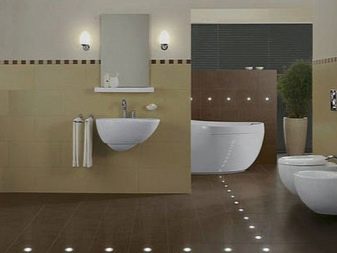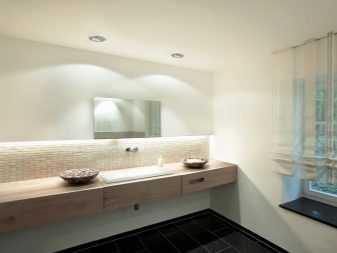Waterproof spotlights for the bathroom
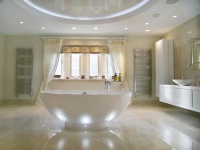
The choice of lighting is not the last place in the renovation process. At times, it is what determines important points when deciding on ceiling finishes and wiring. The purpose of the room determines the requirements for the functionality of the light.
Spot lights are becoming increasingly popular, because they successfully solve the problems of small rooms, not "eating up" the space. In the bathroom it is especially important, and in comparison with the Soviet version of the plafond or proudly hanging from the ceiling Ilyich lamp, spot lighting looks especially aesthetic and even festive.
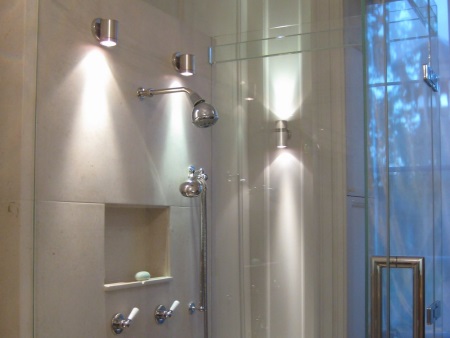
How are they different from conventional ones?
In addition to the marking on the product box and a larger price tag than for a conventional lamp, bathroom light fixtures are distinguished by the quality of workmanship and the presence of additional ways of protection. Rubberized parts, isolating and hiding all wires, sealed housing, tight fitting parts - all these are sure signs that you are holding special lamps for wet room lighting.
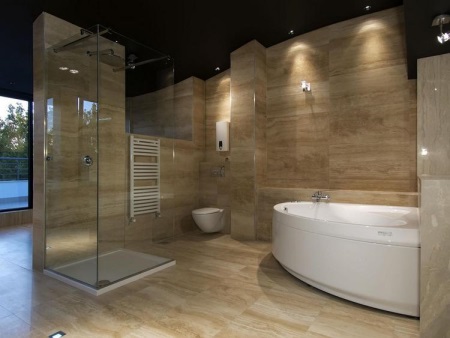
Pros
It is the protection of the person and the lamp from the negative effect of the interaction of metals, current and water with each other - this is the main advantage of spotlights. Such protection also ensures a long life and the lamps have to be replaced less often.
And designers love such systems! There is a lot of advantages: you can zoned space, visually enlarge the room, make a prosaic bathroom truly a royal room! Also spot lighting will distract attention from something less beautiful, will make an elegant accent on a particular part of the interior. For example, a multi-level ceiling, an expensive bath, a large mirror. For the lit mirror you can earn gratitude from the female half, and for men it will be very functional.
A comfortable level of light for the eyes is useful, including for health, it relieves visual stress and gives a psychological relaxation. Doctors are strongly against saving on lighting.
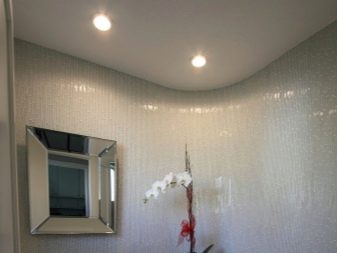
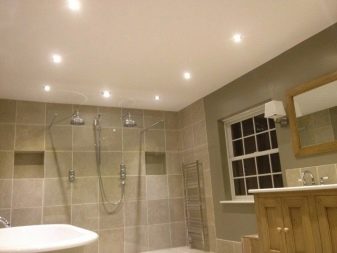
Cons
- Additional equipment. Some types of lamps require the use of transformers (on this information will follow), that is, a little thought before choosing will be necessary.
- Replacing bulbs. The mechanism of moisture-proof devices does not like additional contacts. Therefore, you will not be able to quickly screw in and unscrew the blown bulb at the first time.
- System installation. If you live in an apartment with low ceilings, it will be impossible to install spot lighting on the ceiling without special hinged ceiling systems.
But if you have large voids in the concrete ceiling slab, you can lay wire in them and install spotlights.
And of course, the cost of a one-time investment to buy fixtures is quite large.
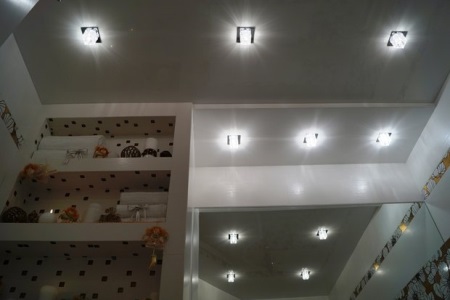
In defense of spot lighting in general, you can say that all these manipulations need not be done so often, especially if you focus on quality brands or work with experienced craftsmen who can give sensible advice on your room.
Types
For bathroom spot lighting, manufacturers now offer:
- incandescent bulbs;
- LED lighting fixtures;
- fluorescent lamps;
- halogen lamps.
In practice, the last three options are popular.
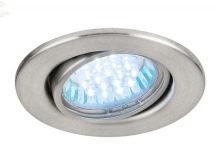
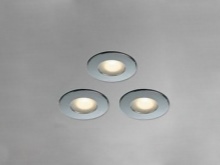

Why not incandescent bulbs? They are good at diffusing light, and for spotlights you have to use devices with an elongated and pear-shaped shape. To make the size smaller, they "save" on power. However, their power consumption is relatively high (20-30 watts per 1 sq.m.), and they burn out faster than other lamps. Therefore, users are rarely interested in options for lighting rooms where "Illich" lamps are required.
Energy-saving, halogen, and LED retrofits have many more supporters. These options consume less electricity, last longer than the one described above. Halogen lamps use up to 10W/sq.m., are somewhat capricious, because their housing reacts negatively to direct contact with the human body (hand), in addition, they need to provide separate disposal. Fluorescent are also demanding on the latter point, but more economical in energy consumption. LED - the most compact and "industrious" lamps, they cost the most. As well as energy-saving lamps, they consume up to 6 W per square meter. Still, the pluses outweigh, otherwise how to explain the number of fans?
An important nuance: diodes usually act as a complement, they are used for decorative purposes, zoning. Colored diode lamps are easier to find, and thanks to the small size, they are well able to withstand mechanical and thermal effects. For the usual understanding of lighting preference is given to energy-saving and halogen lamps.
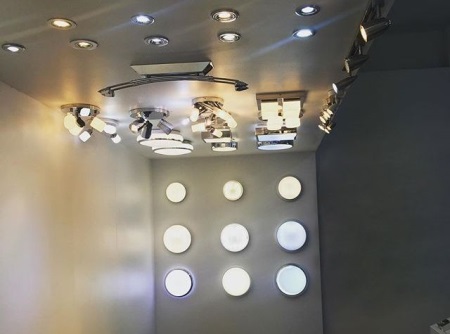
Types according to the method of attachment
With the modern variety of styles used in the interior, it would be strange to have only one option for bathroom lighting. In a specialized store the eyes are simply confused, but in practice everything is much simpler. Moisture-proof fixtures differ in the way they are mounted, the type of grouping, location and type of lamps used.
Rotary and fixed. According to the method of mounting provide soffits and nonrotary lamps. Rotary can change the direction of the beam, which allows you to choose the place of illumination, manually correcting the lamps. This option is often used in other types of rooms, as well as used in chandeliers style hi-tech. For the bathroom, this method is not always suitable, and the design with soffits is more expensive.
The second option involves rigid mounting, so the beam of light hits a specific area and it is impossible to correct it after installation. Therefore, the connection of spot lamps are made by schemes, to be able to choose scenarios, providing illumination by zones or the whole room as a whole. The lamps here will have to use more than in the first case.


Grouping
According to the type of grouping can be divided into three options:
- single;
- mortise;
- remote.
Often the use of one or another option depends on the location. Single ones involve lighting in the form of a wall sconce with a small number of lamps, the functionality of which is limited to the decoration of the room. Recessed lamps "hide" all the wires behind the trim, they are often placed on the ceiling, because no other part of the room can afford to "eat up" the space so that it was not so noticeable. On walls, furniture cabinets use remote options with a compact design of connection and attachment. For large rooms, decorators use floor lighting, but this is more a rarity than the norm.
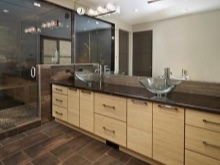
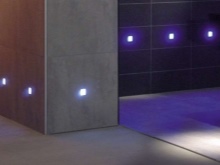
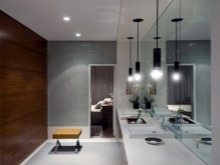
Where to Place?
Our bathrooms are rarely large, they do not often have windows, so the question is particularly acute. Everything that is compact is relevant, to fit on square meters of the most necessary. Therefore, many choose ceiling lighting. Even if you use recessed versions of lights, their designs will be hidden by suspended ceilings or special panels. This is also functional: additional insulation from humid air. This option will give a good background light, but some parts of the room may seem darkened.
Built-in lighting is also used for bathroom furniture. For example, cabinets, to a greater extent this applies to mirrors. Since for many people the bathroom is the room of self-care, the desire to "light up" the mirror is quite logical. When designing, many women will only think about how to make the area near the mirror light, to be able to apply makeup in comfortable conditions. It's more comfortable to shave this way, too, because the possibility of an unfortunate angle becomes lower.
Much less often our people use in the bathroom zoning lighting of vertical surfaces - walls, catwalks, bathtub rims. Serious statuettes and large-scale compositions in this room are placed only wealthy citizens who design invite professionals. Yes, and wall lights often suffer from proximity to wet surfaces and the penetration of water into the device. In large rooms there is less humidity, it will be easier and safer to use this option. Because of the need for room space and freedom to spread light, floor fixtures can also only be afforded by owners of a huge bathroom. In a small room, floor fixtures will get lost, and therefore this option becomes a loser in normal circumstances.
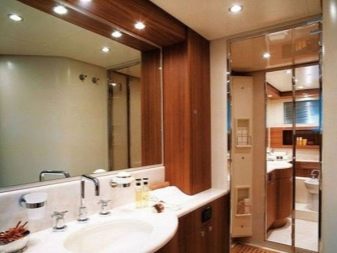
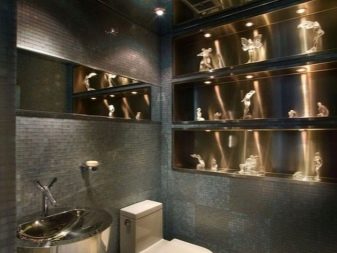
Selection tips
To give an unambiguous conclusion, which light fixture to use, it is impossible. Everyone is used to use the bathroom at his own discretion. However, the choice of spot lighting depends on:
- Functionality. If the mirror in the bathroom is needed only for brushing teeth, then it is not always necessary to illuminate it. But if you want a quality reflection, you can't do without mirror lighting. The questions of zonal lighting are solved similarly.
- Costs. In addition to buying replacement lamps, you need to think about the installation method. The total costs will not be negligible, however, such an investment is long-term, and therefore justified. In order not to regret the money spent, it is worth thinking about 2-3 draft lighting options. This will allow you to compare the potential cost and usefulness for you personally.
- Harmony and beauty. Lighting does not exist separately from the room, its design, color scheme and purpose of the room. Therefore, giving preference to any variant of a spotlight, you need to pay attention to the details that are visible to the eye. Manufacturers are trying to use universal colors - chrome, bronze, gold, copper. Think about what "noble" metal will combine with the color of furniture, tiles, sanitary ware? Matt or shiny? The general style of the room and the chosen fixture also matters.
- Placement and purpose. The degree of protection against interaction with water in lamps is different. Even with very neat owners, water sometimes gets on the mirror. When using local lighting, there is also the danger of a short circuit or electric shock, so safety becomes a priority. You can, of course, perform a minimum of movement so that water splashes don't fly around. Or you can approach it wisely and choose good moisture-resistant lamps that everyone in the home will love. For example, the label on the package IP 44 means that such devices are adapted to infrequent interaction with water, but well tolerate high humidity in the bathroom. And the IP 55 guarantees the endurance of the design to prolonged "watering", such lamps can be placed in close proximity to a water source.
- Power of the lamps. The cost has already been mentioned earlier. You can roughly calculate how many lamps are recommended for comfortable lighting. Consumption rate per square meter is indicated on the box, knowing the size of the bathroom, you can easily determine the necessary amount.
- Quality. Low cost is often synonymous with poor performance and frequent replacement. When choosing the type of fixture and lamps, give preference to trusted brands. Many brands, entering a new market, offer reduced prices for their products. However, quality and compliance with technology and regulations in such a case is difficult to give.
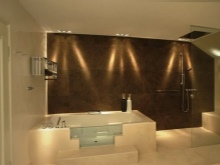
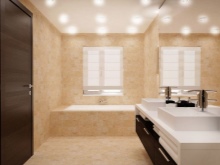
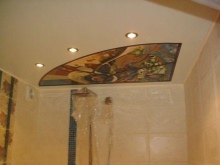
Installation
If we are not talking about suspended ceilings, recessed lamps, the installation of the structure and lighting sources, a relatively simple task. Built-in lamps can be placed only when repairing and installing the surface where the point light will be placed. Such work is best left to professionals. Accurate calculation will help to guarantee safety: only in this case, the conductive parts will be "recessed" and isolated from the damp air.
When working with halogen lamps, do not touch glass containing quartz. Grease traces react chemically, which compromises the safety and integrity of the lamp. And the life of the lamp is greatly reduced because of this.
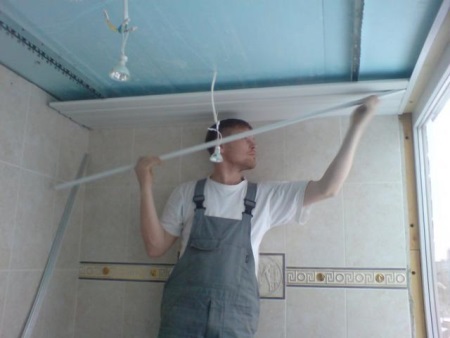
If you need to replace a bulb with a "hidden" housing, you can use this recommendation. Carefully inspect the bulb housing and look for the fixing springs on the bulb. Pressing them firmly against the lamp housing, insert the element into the hole in the socket. After your fingers release the bulb, the "petals" for the fasteners will open and lock the housing into the structure.
There is some debate about installing lamps of different wattages. For maximum-power spotlights, experts advise to buy and protective cutoff devices, which in the event of a malfunction will turn off the lighting in the room and protect against short circuits. In addition, such a device has a function to save energy consumption. But when choosing a low-power option for energy consumption electricians recommend using an adapter - transformer, which will help to adapt the lamp to the voltage difference.

The bathroom - one of the attributes of comfortable life for modern man. Repair in this room do for a very long time, so responsibly approach the issue of design and selection of lighting is extremely important. Giving preference to modern technology and quality materials, you can add elegance to everyday life. The bathroom is used several times a day. Add beauty to your interior, make yourself and your loved ones happy!
